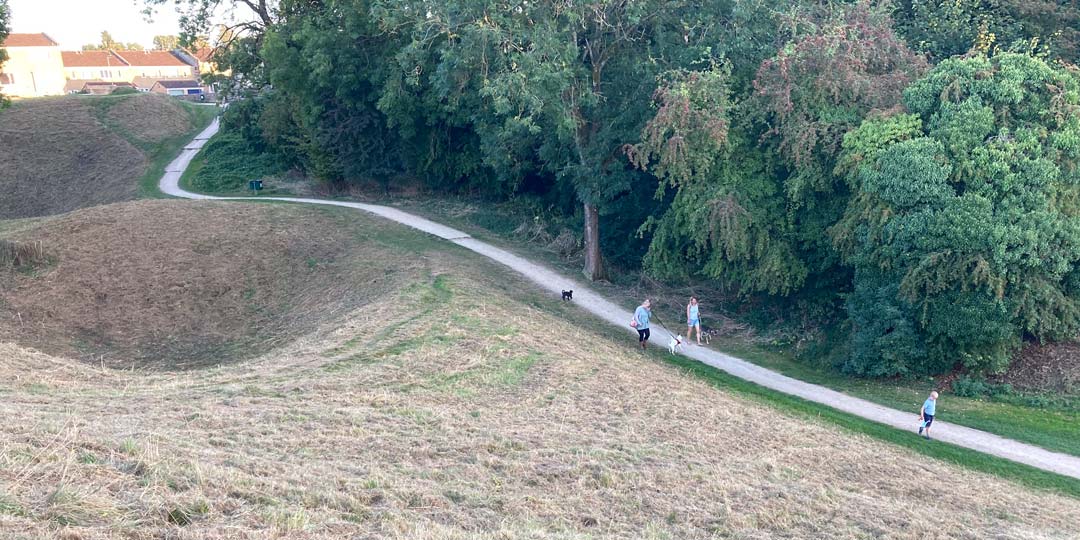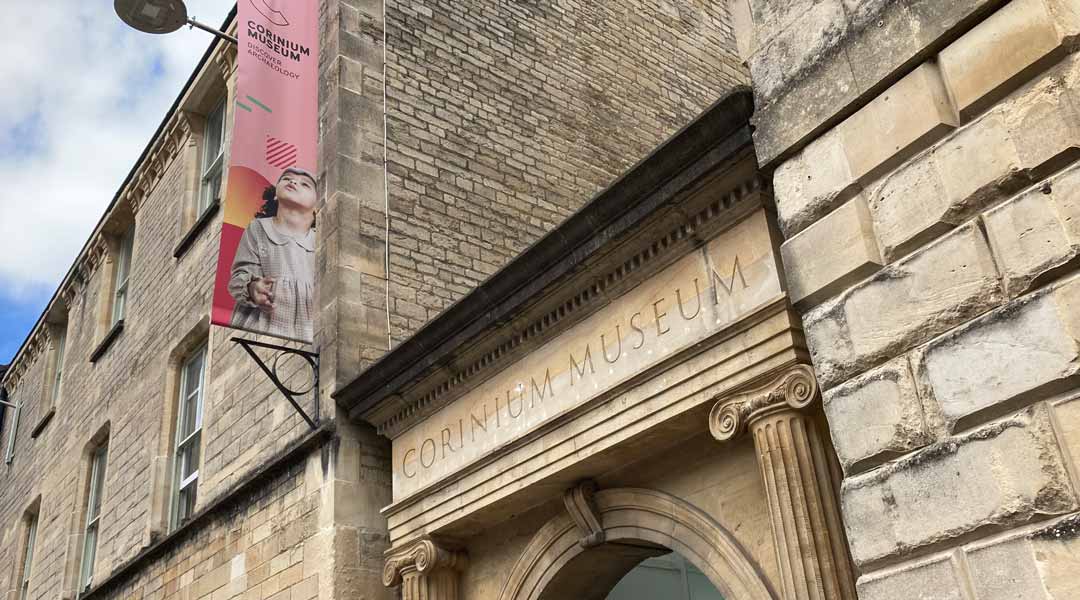Discover Cirencester’s hidden jewel
The Amphitheatre is a powerful reminder of Cirencester’s rich history and how significant the town was in Roman times.
A favourite with walkers and sitters alike, The Amphitheatre is a beautiful place, offering something different in every season: from a glorious carpet of buttercups in spring, to a crisply shimmering wonderland in winter.
Things to see at the Amphitheatre
Aside from taking in the stunning natural surroundings, there are a number of points of interest around The Amphitheatre to look out for.

Toposcope
From the Cotswold Avenue entrance, you’ll find two stone benches framing a circular table map showing Corinium Dobunnorum (Cirencester) and it’s place in Roman Britain.
It provides a fascinating look at the other settlements that existed in Roman times and insights into what the Romans brought to Britain.
Originally planned as a map of Roman Britain, Cirencester Town Council consulted AQIVA and we suggested the addition of illustrations and snippets of historical information that really bring the Toposcope to life.
The Toposcope is part of a wider masterplan for the site of The Amphitheatre to include more infrastructre and easier access from the town centre in future.


Information points
At each entrance to The Amphitheatre itself you’ll find an information point.
One shows what The Amphitheatre might have looked like the 2nd Century AD when Corinium was at its peak. The other provides some details on when the site was first identified as an amphitheatre in 1780, and the site’s excavation in the 1960’s.
The interpretation panels are provided by English Heritage Trust. The charity cares for more than 400 sites across the country.
Where is Cirencester Amphitheatre?
Located between Cotswold Avenue and Cirencester Hospital, The Amphitheatre is easy to find. It’s a short walk from the town centre and there is parking by the site.
Cotswold Avenue, Cirencester, Gloucestershire, GL7 1XW
Getting there on foot

It’s about 10 minutes walk from the town centre. Follow Sheep Street up the hill and over the bridge that crosses the bypass (A429). From the bridge you’ll see brown “Roman Amphitheatre” signposts. Round the bend onto Cotswold Avenue and the entrance is just up the hill on your right.
Getting there by vehicle

At the bottom of Cotswold Avenue you’ll find the Scout Hut carpark, where visitors to The Amphitheatre can park. Just up past the Obelisk you’ll cross a little bridge leading to the toposcope. Follow the main path down the hill to the south entrance of The Amphitheatre.
2,000 years of history

In 43AD, the Roman Imperial Army landed in Richborough, Kent and began the Roman conquest of the British Isles. By 47AD the Romans had secured a frontier than ran from the River Severn in the west to the Wash in the east.
Where this frontier met the River Churn, the Romans built a defensive fort and a settlement began to grow beside it, drawing in local people.
By 70 CE the fort was no longer needed and the settlement steadily transforming into a city, with streets and stone buildings, a thriving livestock market and by the start of the 2nd Century, a forum, basilica, and The Amphitheatre itself had been built.

By this time, Corinium (the Roman name for Cirencester) was second only to Londinium (modern London) in terms of size.
Entertainment, justice and spectacle
With tiered seating for 8,000 people, Cirencester Amphitheatre was the second largest in Roman Britain. Amphitheatres were home to a variety of entertainments and events from gladitorial combat to public executions.
The road leading from the town to The Amphitheatre might well have been lined with stalls selling food and goods to the visiting spectators.


Image © Corinium Museum
The Amphitheatre remained active through the 4th Century, but by the 5th Century the Empire was in trouble and the soldiers were recalled to defend Rome from invaders, leading to the rapid decline of the town and more or less the end of Roman rule in Britain.
After the Romans

In 6th Century CE the Saxon invasion of Britain was well underway and The Amphitheatre was fortified and repurposed into a stronghold to defend against raiders. Evidence suggests that in 577 CE the stronghold fell to the Saxons.
The Amphitheatre was then abandoned for several centuries.
In the Middle Ages, records show that the site was enclosed to create a rabbit warren for the Abbot of Cirencester.
Locally, the amphitheatre is often known by the nickname “The Bull Ring”, which suggests the site might have been used for activities like bull-baiting (a blood sport) but there is no evidence beyond the name.

The Amphitheatre in the modern era
It’s history forgotten for centuries, the site was mentioned by topographer and antiquarian Samuel Rudder in his 1780 work The History and Antiquities of Cirencester.
It was almost 200 years later in the 1960s that archeologists excavated the site, discovering a number of artifacts such as coins, and confirming that it had indeed been a Roman Amphitheatre, with dry stone walls and timber supports and seating.

Image © Corinium Museum
Discover more about the history of Cirencester and The Amphitheatre

Read our detailed history
Dive deeper into the complete story of The Amphitheatre before and during the Roman era with our extensive history.

Visit the Corinium Museum
Bringing Roman Cirencester to life like nowhere else, the Corinium Museum houses a treasure trove of artifacts and information.
Conservation at The Amphitheatre
AQIVA help look after the amphitheatre to protect it as a scheduled ancient monument and enhance it as a natural community space. We work closely with Cirencester Town Council, English Heritage and other partners.

In high traffic areas, particularly low lying ones, mesh matting has been laid to protect the grass. They go a long way toward preventing these areas from becoming muddy bogs in wetter months.

Cirencester Town Council has erected fences to try and dissuade people from climbing up the sides of The Amphitheatre, in an effort to slow the erosion of the ancient earthworks.

Education
An important part of our conservation efforts is community engagement, educating people about the historical significance and fragility of the site.
Here Aqiva member Richard gives a guided walk of the site as part of Heritage Open Days in September 2021.
Become a member of AQIVA
We are always looking for new members to join us and help out with our range of activities.
Learn more about what we do by clicking the link below.



